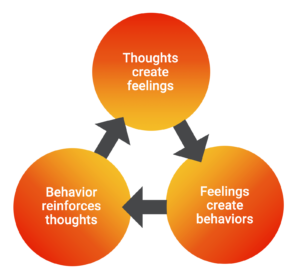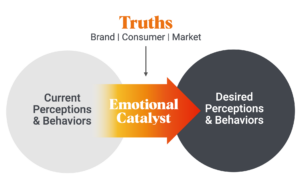Establishing strong emotional connections has become an essential element for success in the world of marketing communications. Making connections with your audience gives you the power to shape consumer behavior and drive meaningful change. Here we’ll explore the psychological factors behind emotional connections, help you understand their significance, and discuss how to use these psychological truths to drive behavior change.
Let’s start with this simple model

Making strong emotional connections lets our audience know that we know how they feel. We hear what’s important to them. We understand. Making that connection can be a powerful tool, and CCF has branded that tool the “Emotional Catalyst,” because science shows it’s instrumental in behavior change.

The Power of Emotional Connections
When you make an emotional connection with your audience, you differentiate your brand from your competitors and create a lasting impression. Tapping into consumers’ core values and aspirations can turn your customers into loyal advocates. This relationship pays dividends through positive word-of-mouth and greater engagement.
There are many tried-and-true techniques for building an emotional connection with your reader. Here are three to try:
• Storytelling
People are practically hardwired to respond to stories. When you incorporate the right narrative, your communications become more than just a message. They can evoke emotions and create relatable experiences that resonate.
• Personalization
Tailoring messages to individual preferences and values enhances emotional connections. Make your audience feel understood and valued to form a deeper bond.
• Authenticity
Being genuine and transparent is crucial in establishing trust. Authenticity creates a sense of credibility and reliability, strengthening the emotional connection between a brand and its audience.
Empathy and Emotional Connections
Empathy plays a significant role in establishing emotional connections. Understanding your audience’s needs, challenges, and motivators allows you to create messages that reach them on a deeper level. Demonstrating empathy fosters a sense of understanding and shared values. Once you’ve made an emotional connection with your audience, you can use the good feelings associated with it to build a better relationship.
Making an emotional connection with your audience is one of the best ways to improve your long-term brand recognition and advocacy, and eventually, your profit margin. Storytelling techniques are some of the most powerful tools you have for building these connections. Even though people come from many different cultural, social, and economic backgrounds, we are all remarkably similar in many ways. If you want to create meaningful and impactful interaction with your audience, understanding the psychological factors of emotional connections is a crucial first step.






